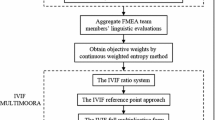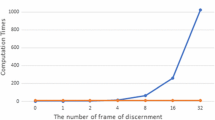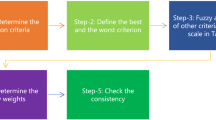Abstract
In traditional approach, failure mode and effects analysis determines the risk priories of failure modes through the risk priority number which is determined by multiplication of three risk factors namely, failure occurrence (O), failure severity (S) and failure detection ability (D). In this approach, different weights of risk factors were not taken into consideration so that the three risk factors were assumed to have the same weight. This may not be realistic in real applications. In this paper we treat the risk factors as fuzzy variables and evaluate them using fuzzy linguistic terms and fuzzy ratings. As a result, fuzzy risk priority numbers (FRPNs) are proposed for prioritization of failure modes. The FRPNs are defined as fuzzy geometric means of the fuzzy ratings for O, S and D and can be computed using alpha-level sets and linear programming models. A numerical example is provided to examine the results of this model.
Similar content being viewed by others
References
Bevilacqua M, Braglia M, Gabbrielli R (2000) Monte Carlo simulation approach for a modified FMECA in a power plant. Qual Reliab Eng Int 16:313–324
Braglia M, Frosolini M, Montanari R (2003) Fuzzy TOPSIS approach for failure mode, effects and criticality analysis. Qual Reliab Eng Int 19:425–443
Bowles JB, Pelez CE (1995) Fuzzy logic prioritization of failures in a system failure mode, effects and criticality analysis. Reliab Eng Syst Saf 50:203–213
Braglia M (2000) MAFMA: multi-attribute failure mode analysis. Int J Qual Reliab Manag 17(9):1017–1033
Braglia M, Frosolini M, Montanari R (2003) Fuzzy criticality assessment model for failure modes and effects analysis. Int J Qual Reliab Manag 20(4):503–524
Chang CL, Wei CC, Lee YH (1999) Failure mode and effects analysis using fuzzy method and grey theory. Kybernetes 28:1072–1080
Chang CL, Wei CC, Lee YH (2001) Failure mode and effects analysis using fuzzy method and grey theory. Integr Manuf Syst 12(3):211–216
Chin KS, Wang YM, Poon GKK, Yang J-B (2009) Failure mode and effects analysis by data envelopment analysis. Decis Support Syst 48:246–256
Delgado M, Verdegay JL, Vila V (1993) Linguistic decision making models. Int J Intel Syst 7:479–492
Dyer JS, Sarin RK (1979) Measurable multi-attribute value functions. Oper Res 39:810–822
Garcia PAA, Schirru R, Frutuoso E, Melo PF (2005) A fuzzy data envelopment analysis approach for FMEA. Prog Nucl Energy 46(3-4):59–373
Hsiao WF, Lin HH, Chang TM (2008) Fuzzy consensus measure on verbal opinions. Expert Syst Appl 35(3):836–842
Sankar NR, Prabhu BS (2001) Modified approach for prioritization of failures in a system failure mode and effects analysis. Int J Qual Reliab Manag 18(3):324–335
Sharma RK, Kumar D, Kumar P (2008) Fuzzy modeling of system behavior for risk and reliability analysis. Int J Syst Sci 39(6):563–581
Segismundo A, Augusto P, Miguel C (2008) Failure mode and effects analysis (FMEA) in the context of risk management in new product Development, A case study in an automotive company. Int J Qual Reliab Manag 25(9):899–912
Wang YM, Chin KS, Poon KKG, Yang JB (2009) Risk evaluation in failure mode and effects analysis using fuzzy weighted geometric mean. Expert Syst Appl 36(2):1195–1207
Xiao N, Huang H-Z, Li Y, He L, Jin T (2011) Multiple failure modes analysis and weighted risk priority number evaluation in FMEA. Eng Fail Anal 18(4):1162–1170
Yang J, Huang H-Z, He L-P, Zhu S-P, Wen D (2011) Risk evaluation in failure mode and effects analysis of aircraft turbine rotor blades using Dempster-Shafer evidence theory under uncertainty. Eng Fail Anal 18(8):2084–2092
Yang Z, Bonsall S, Wang J (2008) Fuzzy rule-based Bayesian reasoning approach for prioritization of failures in FMEA. IEEE Trans Reliab 57(3):517–528
Yue Z (2011) An extended TOPSIS for determining weights of decision makers with interval numbers. Knowl Based Syst 24(1):146–153
Zhang Z, Chu X (2011) Risk prioritization in failure mode and effects analysis under uncertainty. Expert Syst Appl 38(1):206–214
Acknowledgements
The authors would like to thank anonymous referees for their helpful comments and suggestions on the first version of this paper.
Author information
Authors and Affiliations
Corresponding author
Rights and permissions
About this article
Cite this article
Hadi-Vencheh, A., Hejazi, S. & Eslaminasab, Z. A fuzzy linear programming model for risk evaluation in failure mode and effects analysis. Neural Comput & Applic 22, 1105–1113 (2013). https://doi.org/10.1007/s00521-012-0874-9
Received:
Accepted:
Published:
Issue Date:
DOI: https://doi.org/10.1007/s00521-012-0874-9




